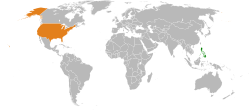- Mutual Defense Treaty (U.S.–Philippines)
-
Philippines – United States Mutual Defense Treaty relations 

Philippines
United StatesThe Mutual Defense Treaty Between the Republic of the Philippines and the United States of America was signed on August 30, 1951 in Washington, D.C. between representatives of the Philippines and the United States. The overall accord contained eight articles and dictated that both nations would support each other if either the Philippines or the United States were to be attacked by an external party.
Contents
Text
The Parties to this Treaty,
Reaffirming their faith in the purposes and principles of the Charter of the United Nations and their desire to live in peace with all peoples and all Governments, and desiring to strengthen the fabric of peace in the Pacific Area,
Recalling with mutual pride the historic relationship which brought their two peoples together in a common bond of sympathy and mutual ideals to fight side-by-side against imperialist aggression during the last war,
Desiring to declare publicly and formally their sense of unity and their common determination to defend themselves against external armed attack, so that no potential aggressor could be under the illusion that either of them stands alone in the Pacific Area,
Desiring further to strengthen their present efforts for collective defense for the preservation of peace and security pending the development of a more comprehensive system of regional security in the Pacific Area,
Agreeing that nothing in this present instrument shall be considered or interpreted as in any way or sense altering or diminishing any existing agreements or understandings between the United States of America and the Republic of the Philippines,
Have agreed as follows:
Article I
The Parties undertake, as set forth in the Charter of the United Nations, to settle any international disputes in which they may be involved by peaceful means in such a manner that international peace and security and justice are not endangered and to refrain in their international relations from the threat or use of force in any manner inconsistent with the purpose of the United Nations.
Article II
In order more effectively to achieve the objective of this Treaty, the Parties separately and jointly by self-help and mutual aid will maintain and develop their individual and collective capacity to resist armed attack,
Article III
The Parties, through their Foreign Ministers or their deputies, will consult together from time to time regarding the implementation of this Treaty and whenever in the opinion of either of them the territorial integrity, political independence or security of either of the Parties is threatened by external armed attack in the Pacific.
Article IV
Each Party recognizes that an armed attack in the Pacific Area on either of the Parties would be dangerous to its own peace and safety and declares that it would act to meet the common dangers in accordance with its constitutional processes. Any such armed attack and all measures taken as a result thereof shall be immediately reported to the Security Council of the United Nations. Such measures shall be terminated when the Security Council has taken the measures necessary to restore and maintain international peace and security.
Article V
For the purpose of Article IV, an armed attack on either of the Parties is deemed to include an armed attack on the metropolitan territory of either of the Parties, or on the island territories under its jurisdiction in the Pacific or on its armed forces, public vessels or aircraft in the Pacific.
Article VI
This Treaty does not affect and shall not be interpreted as affecting in any way the rights and obligations of the Parties under the Charter of the United Nations or the responsibility of the United Nations for the maintenance of international peace and security.
Article VII
This Treaty shall be ratified by the United States of America and the Republic of the Philippines in accordance with their respective constitutional processes and will come into force when instruments of ratification thereof have been exchanged by them at Manila.
Article VIII
This Treaty shall remain in force indefinitely. Either Party may terminate it one year after notice has been given to the other Party.
Signatories
IN WITNESS WHEREOF the undersigned Plenipotentiaries have signed this Treaty.
DONE in duplicate at Washington this thirtieth day of August 1951.
FOR THE REPUBLIC OF THE PHILIPPINES:
(SGD) CARLOS P. ROMULO
(SGD) JOAQUIN M. ELIZALDE
(SGD) VICENTE J. FRANCISCO
(SGD) DIOSDADO MACAPAGAL
FOR THE UNITED STATES OF AMERICA:
(SGD) DEAN ACHESON
(SGD) JOHN FOSTER DULLES
(SGD) TOM CONNALY
(SGD) ALEXANDER WILEY
Source
Categories:- Treaties concluded in 1951
- Military alliances involving the Philippines
- Military alliances involving the United States
- 20th-century military alliances
- 1951 in the Philippines
- 1951 in the United States
- Philippines–United States relations
Wikimedia Foundation. 2010.
